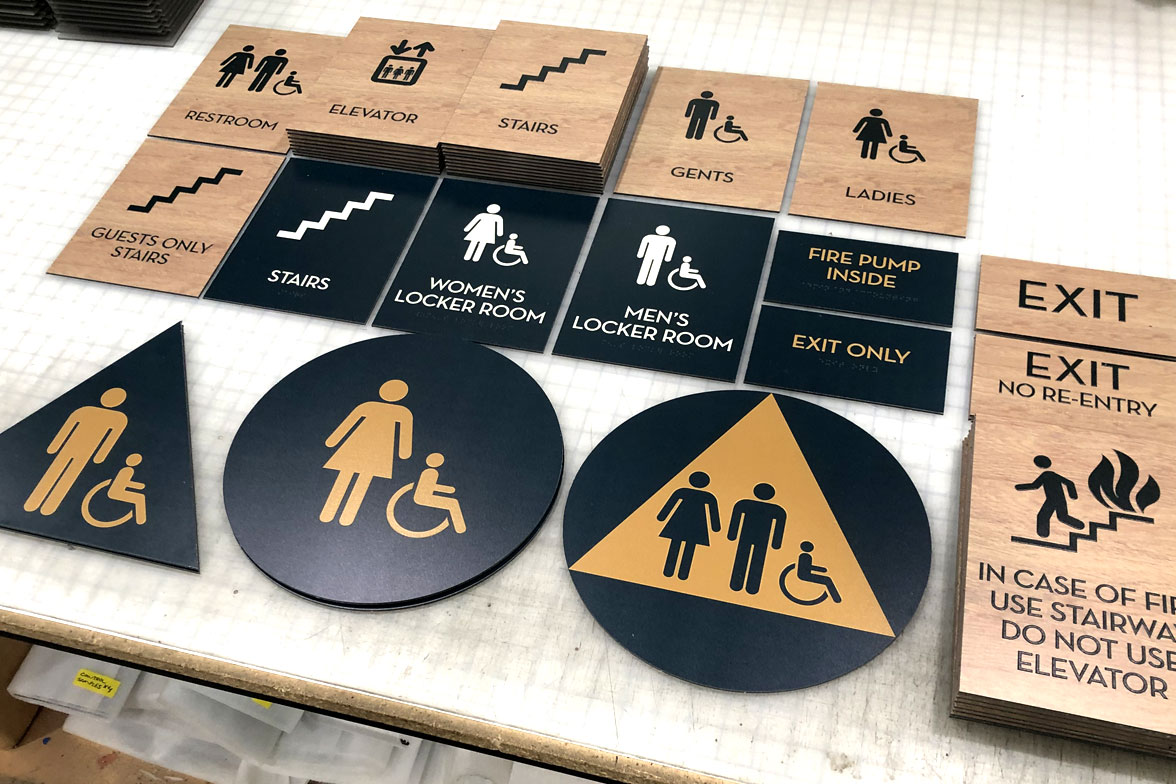Customizing ADA Signs to Fulfill Your Details Demands
Customizing ADA Signs to Fulfill Your Details Demands
Blog Article
Discovering the Key Features of ADA Indications for Improved Availability
In the realm of ease of access, ADA indications serve as quiet yet powerful allies, ensuring that spaces are accessible and inclusive for individuals with disabilities. By incorporating Braille and responsive elements, these indicators damage obstacles for the aesthetically impaired, while high-contrast color plans and readable font styles provide to varied visual needs.
Significance of ADA Compliance
Making certain conformity with the Americans with Disabilities Act (ADA) is essential for cultivating inclusivity and equal gain access to in public rooms and workplaces. The ADA, passed in 1990, mandates that all public centers, employers, and transport solutions suit individuals with handicaps, ensuring they take pleasure in the same legal rights and opportunities as others. Conformity with ADA requirements not just meets legal commitments yet also enhances a company's online reputation by demonstrating its commitment to variety and inclusivity.
One of the key aspects of ADA compliance is the implementation of accessible signage. ADA indications are created to guarantee that individuals with specials needs can conveniently navigate through buildings and spaces. These signs have to adhere to certain standards concerning dimension, font, shade contrast, and placement to assure exposure and readability for all. Properly applied ADA signage assists get rid of barriers that people with disabilities typically come across, therefore promoting their self-reliance and confidence (ADA Signs).
Additionally, adhering to ADA regulations can mitigate the risk of potential penalties and lawful consequences. Organizations that stop working to abide by ADA standards might deal with suits or penalties, which can be both financially challenging and harmful to their public photo. Therefore, ADA compliance is integral to fostering a fair environment for every person.
Braille and Tactile Aspects
The incorporation of Braille and responsive aspects into ADA signage personifies the principles of ease of access and inclusivity. It is typically put beneath the corresponding message on signage to make sure that people can access the information without visual support.
Tactile components expand past Braille and consist of elevated personalities and icons. These parts are developed to be noticeable by touch, allowing people to recognize area numbers, restrooms, exits, and other vital locations. The ADA sets particular guidelines relating to the size, spacing, and placement of these tactile components to optimize readability and guarantee consistency throughout different atmospheres.

High-Contrast Color Design
High-contrast color pattern play a pivotal role in enhancing the presence and readability of ADA signs for individuals with visual problems. These schemes are important as they maximize the difference in light reference reflectance in between text and history, guaranteeing that signs are quickly discernible, also from a distance. The Americans with Disabilities Act (ADA) mandates using certain shade contrasts to fit those with restricted vision, making it a vital aspect of compliance.
The effectiveness of high-contrast shades hinges on their ability to stand apart in various lights problems, consisting of dimly lit settings and areas with glow. Typically, dark message on a light history or light text on a dark background is used to accomplish optimal contrast. For example, black text on a white or yellow history supplies a plain visual distinction that assists in fast recognition and comprehension.

Legible Fonts and Text Size
When thinking about the design of ADA signage, the choice of understandable fonts and proper text dimension can not be overemphasized. These aspects are crucial for making sure that signs are available to individuals with visual disabilities. The visit this web-site Americans with Disabilities Act (ADA) mandates that font styles must be not italic and sans-serif, oblique, manuscript, very ornamental, or of unusual form. These needs help make certain that the text is easily legible from a distance and that the personalities are distinct to diverse audiences.
According to ADA guidelines, the minimum message elevation ought to be 5/8 inch, and it must increase proportionally with viewing range. Consistency in message dimension adds to a natural aesthetic experience, helping individuals in browsing settings successfully.
Furthermore, spacing in between lines and letters is integral to clarity. Adequate spacing prevents characters from appearing crowded, boosting readability. By adhering to these criteria, developers can dramatically improve access, guaranteeing that signs offers its intended objective for all people, despite their aesthetic capacities.
Efficient Placement Strategies
Strategic placement of ADA signage is important for making best use of accessibility and ensuring conformity with lawful criteria. ADA standards stipulate that signs should be placed at an elevation between 48 to 60 inches from the ground to ensure they are within the line of view for both standing and seated people.
Furthermore, signs must be positioned nearby to the lock side of doors to enable easy recognition before entry. Uniformity in indication placement throughout a facility enhances predictability, decreasing confusion and boosting general individual experience.
Verdict
ADA indications play an essential duty in advertising access by incorporating features that address the demands of individuals with specials needs. These elements collectively cultivate an inclusive setting, highlighting the importance of ADA conformity in making certain equivalent access for all.
In the world of ease of access, ADA indicators offer as quiet yet effective allies, ensuring that rooms are navigable and comprehensive for people with specials needs. The ADA, passed in 1990, mandates that all public centers, employers, and transportation solutions accommodate individuals with impairments, ensuring they take pleasure in the same legal rights and opportunities as others. ADA Signs. ADA signs are designed to guarantee that people with impairments can quickly navigate with spaces and structures. ADA standards stipulate that signs must be mounted at a height between 48 to 60 inches from the ground to guarantee they are within the line of sight for both standing and seated people.ADA indications play an essential function in promoting accessibility by incorporating attributes that address the demands of individuals with handicaps
Report this page